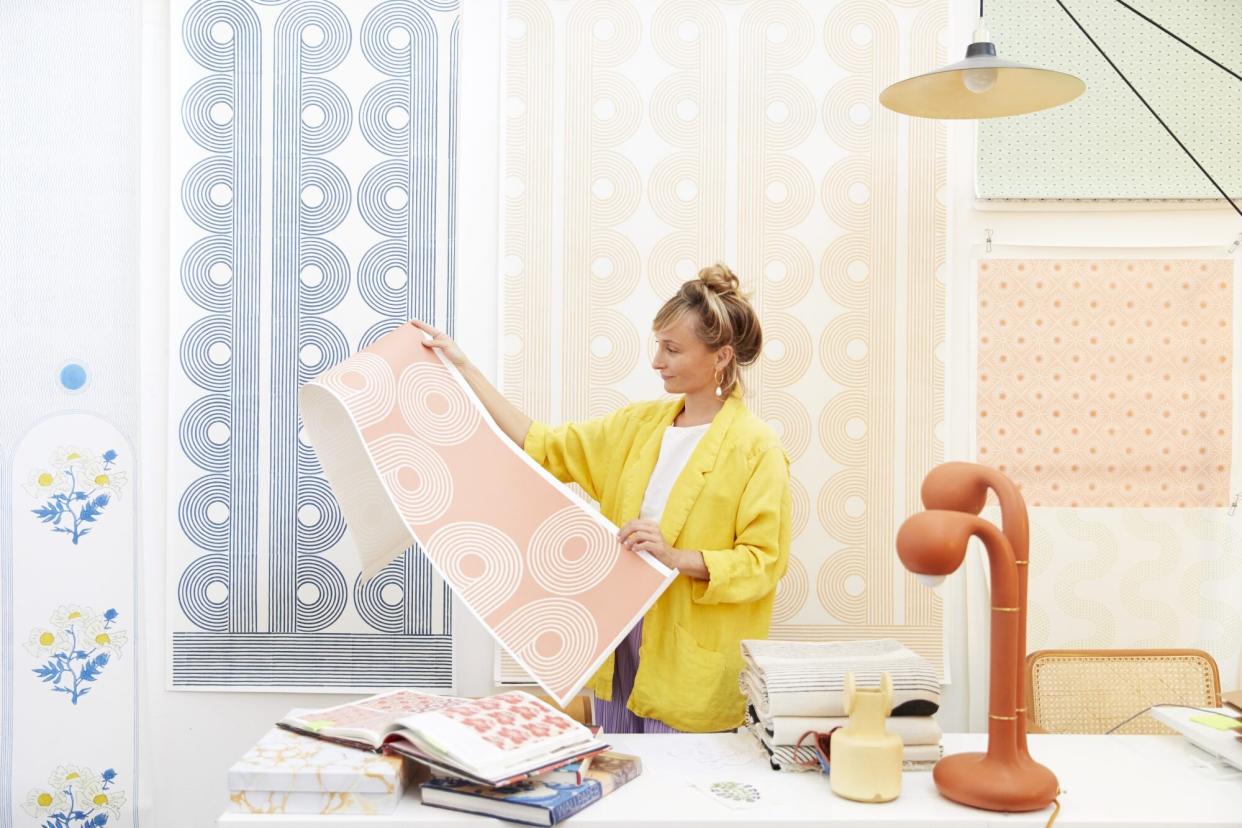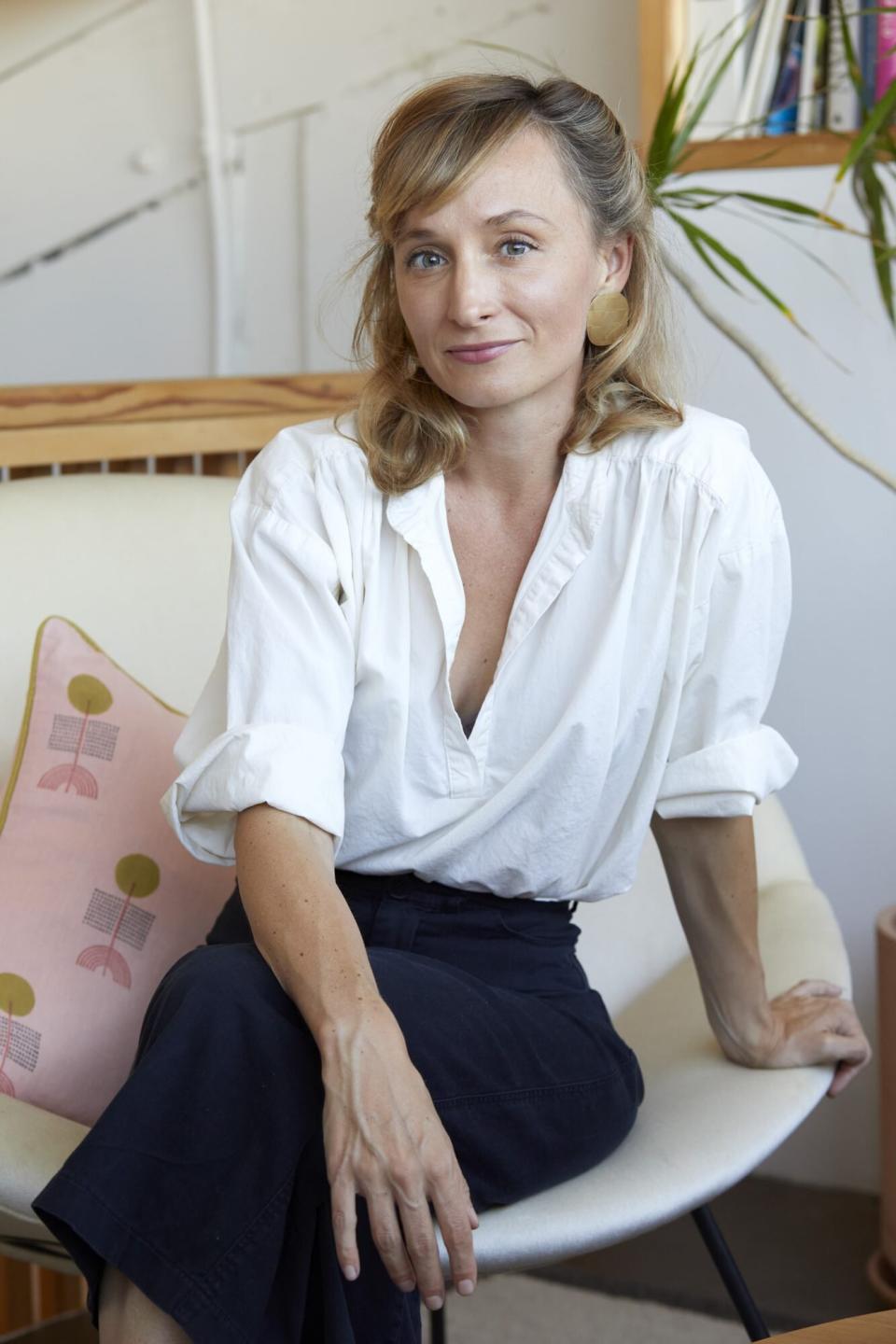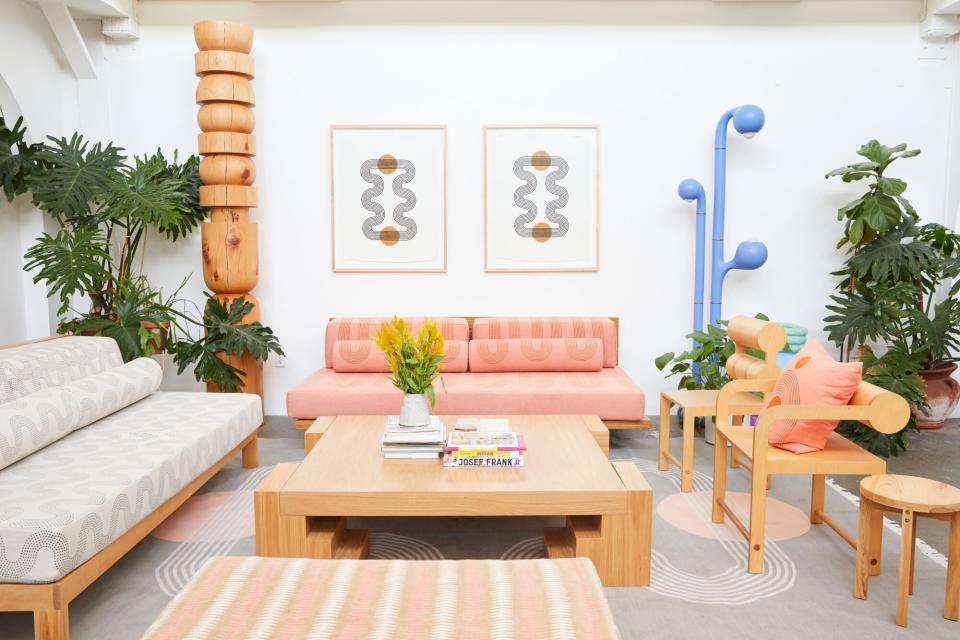Hopie Stockman's Textiles Are an Ode to Block Printing and Weaving Techniques Dating Back Centuries

Courtesy of Block Shop Textiles
Have you ever wondered how to turn your dreams of owning your own business into a reality? We can help. Each week, as part of our Self Made series, we showcase female entrepreneurs—as well as their quality handmade goods—and share their best advice related to starting, maintaining, and growing your own business.
Sisters Hopie and Lily Stockman created Block Shop Textiles, which sells everything from scarves and robes to rugs and homewares, to bring the printing techniques they have admired throughout their lives to the forefront of their industry. "My three sisters and I grew up painting murals on the garage floor, sewing, and building things, all thanks to a mom who loved to drag us to Shaker villages around New England to study Shaker craftsmanship," says Hopie, the CEO of the business. "We even went to a weaving camp together."
The Stockman sisters fell in love with the world of textiles and its intricate, handmade artistic processes. "We think of textiles as unique pieces of art to live with, which is always how we've approached the design process," Hopie says. The CEO dives into the business origin story of Block Shop and how the brand has evolved through its nearly decade-long run.
Related: How to Get Your Product Made: Finding and Working with a Manufacturer
Grassroots Operation
Block Shop began as Hopie and Lily's sibling passion project in 2013. "We'd always dreamed of running a creative business together as sisters, and an opportunity presented itself when Lily was living in India, where she met a co-op of block printers seeking partnership to help grow the market for their block prints," Hopie says.
What you need is a point of view (a voice, an aesthetic, a target customer, and an ethos), and a willingness to do the constant uphill work of seeing projects through.
—Hopie stockman, CEO of block shop textiles
They veered away from the rapid-growth, venture-backed direct-to-consumer business models during that time, and instead focused on supporting the textile traditions dating back hundreds of years. "We set out to design a small collection of scarves that supported the art of block printing by paying fair wages, investing 5 percent of profits into community health initiatives, lowering environmental impact via textile waste reuse, and providing women with training and earning power whenever possible," Hopie says.
They launched their business by creating 300 units of scarves with a $5,000 loan from their mom, which they repaid as soon as they launched. To this day, the pair prioritize creativity, beauty, and compassion in their work. Now they have extra hands on deck and a more structured business to keep moving forward. "We're now a flourishing small business with a team of eight women and non-binary people in Los Angeles, and textile partnerships in Italy, India, and the United States," Hopie says. "We approach design with a spirit of creative experimentation, which is what continues to make day-to-day work feel interesting."

Block Shop Textiles
Designing with Intention
Hopie leads Block Shop's design and business operations, all of which are centered on working on a small scale to meet the team's standards of fair wages, healthy working conditions, low environmental impact, and gender equity. "We feel extremely lucky to be partnered with leaders in these practices, from the family-owned cashmere recycling mill we work with in Italy, to V-Weave, our craftmark-certified weavers in Panipat, India," she says. This benefits both the artisans and consumers. When a product is thoughtfully made—from initial design concept, to the fabrication process, to the packaging—you can feel the intentionality in the object when you hold it in your hands," she adds.
Creative Flow
When designing, Hopie explains that she and her team draw inspiration from the art and architecture of their surroundings in Southern California, looking to its gardens to create botanical prints to architecture when inventing their signature block-style motifs. "We pull our geometric vernacular from Art Deco carpets, Mughal architecture, Russian constructivist painting, and pioneering artists Anni and Josef Albers," Hopie says.
The creatives begin by making sketches; these move through their review processes and turn into digital files, which they then send to their team in India or Italy. All of their products are made from hand with hand block printing and weaving design techniques. "For block prints, our drawings are hand-carved into wooden blocks no larger than 8 by 10 inches," Hopie says. Each color requires a different block, and their printers line up the patterns simply by eyeballing its registration.
Rugs are woven manually, too. The cotton yarn is dyed by hand and then woven on handlooms by artists outside of Jaipur. The cashmere is woven in Prato, Italy, where fine fibers separated from cashmere waste are re-carded into a super luxe yarn, which is over-dyed and woven into Block Shop's signature geometric patterns.

Courtesy of Block Shop Textiles
Created for the Comfort of Home
When she started out, Hopie feared that she and her team didn't have a "disruptive" idea or perfect-enough product to successfully launch. Along the way, she learned that she didn't need a perfect business plan to get going, and that tweaking when necessary is normal—and fun. "What you do need is a point of view (a voice, an aesthetic, a target customer, and an ethos), and a willingness to do the constant uphill work of seeing projects through," she says. Hopie recommends that business owners become their own biggest fans when launching a brand, just like she is of her own textiles. She designs with the intention of putting these creations in her own abode.
Block Shop's products are meant to celebrate an interior's full expression and provide a sense of joy for everyone inside of it. "If the pandemic has shown us anything about our industry, it's that home design is about so much more than frivolous decoration," Hopie says. "It's about creating an interior world that helps soften the edges of exterior life's daily challenges." Her hope is that the textiles can exist alongside other loved objects in a home.
Building a Community-Based Brand
Hopie and her team support locals by donating 5 percent of profits to community initiatives in Los Angeles and India. In India, they fund biannual health camps and partner with a local occupational health NGO to bring eye doctors, dentists, and general practitioners from nearby Jaipur to run check-ups for their artist communities. In Southern California, they work with two nonprofits that provide arts education, therapy, and training to under-resourced youth.
The team is continuing to build out their brand with the launch of a new wallpaper made in partnership with their Connecticut-based printers, Twenty2. Hopie's goal is to see the wallpaper in homes, hotels, and workspaces around the world over the next year.
In terms of future goals? She hopes to maintain their creative vision. "Social media can make me feel like we need to be doing more, but when I step back, I'm happy with where we are at," she says. "We're going on year 10. We started with scarves and have expanded into a full suite of home products, including artwork, rugs, and wallpaper. We continue to bring beauty into the world, create jobs, and celebrate the textile processes we've come to love so dearly."

